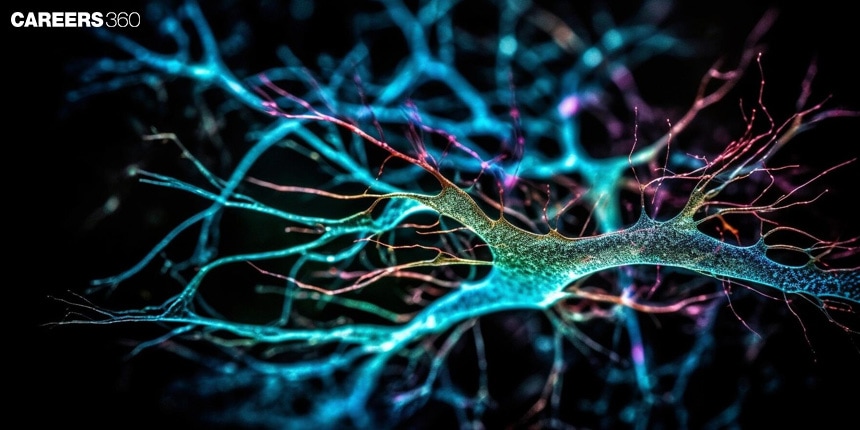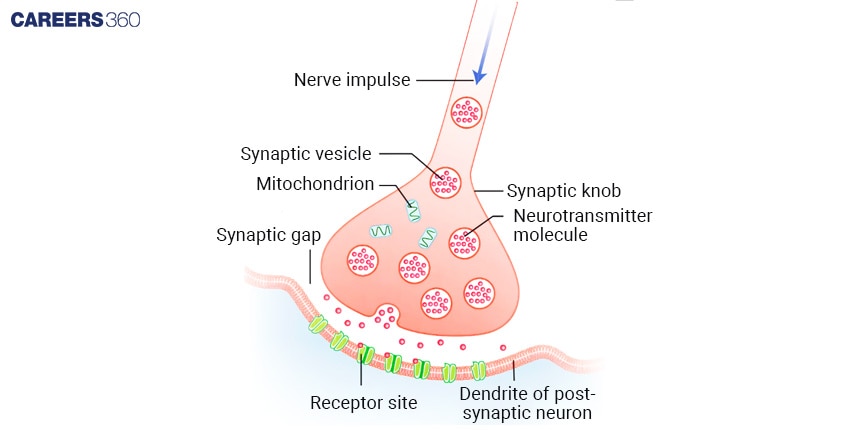Nerve Impulse: Definition, Meaning, Diagram, Steps, Phases, Process
Nerve Impulse Definition
A nerve impulse is the main electrical signal that moves through dendrites and axons to send information from one nerve cell to another. This is how the nervous system operates for all kinds of activities, whether moving muscles or thinking.
The Nervous System And Neurons
The nervous system works like the body’s message system. It controls the myriad messages going back and forth between different parts of the body. Muscles: Muscles are the main components of muscles. Information is collected and transmitted through electronic messages and this information is also analysed.
NEET 2025: Mock Test Series | Syllabus | High Scoring Topics | PYQs
NEET Important PYQ's Subject wise: Physics | Chemistry | Biology
New: Meet Careers360 B.Tech/NEET Experts in your City | Book your Seat now
- Nerve Impulse Definition
- The Nervous System And Neurons
- Structure Of A Neuron
- What Is A Nerve Impulse?
- Mechanism Of Nerve Impulse
- Generation Of Nerve Impulse
- Propagation Of Nerve Impulse
- Synaptic Transmission
- Factors Affecting Nerve Impulse Transmission
- Nerve Impulse Related Disorders
- Importance And Applications Of Nerve Impulses
- Recommended Video On ‘Nerve Impulse’

The nervous system is split into two parts: the central nervous system (CNS), which includes the brain and spinal cord, and the peripheral nervous system (PNS), which includes all the other nerve parts not in the CNS.
The nervous system coordinates both the actions we can control and those we can't, and it also sends signals throughout the body.
Structure Of A Neuron
Dendrites: Dendrites receive signals from other neurons and also from sensory cells.
Soma: Contains the nucleus and supports the health of the neuron.
Axon: Transports electrical messages away from the cell body to other locations.
Myelin Sheath: Sheath around the axon to speed up impulse transmission.
Axon Terminals: Sends the message on its way to another neuron, muscle, or gland by synapsing.
What Is A Nerve Impulse?
A Nerve impulse is an electrical signal that travels down the axon of a neuron, very important in the communication and passage of information throughout the nervous system.
Mechanism Of Nerve Impulse
Resting potential: Inside a nerve cell, there's a neat setup of electric charges. It's slightly negative because of a special pump that moves sodium and potassium ions.
Action potential: This is when the cell quickly sends a message down its long part (axon) and the electric charge changes.
Refractory period: After sending a signal, the cell needs a break and can't send another one right away. This makes sure the message goes in one direction only.
Generation Of Nerve Impulse
Making a nerve signal involves a series of electrical events on the surface of a nerve cell. It begins with the cell at rest, then it sends a signal, and finally, it takes a short break before it can send another signal.
Resting Potential
The maintenance of membrane potential by the sodium-potassium pump, which functions to not allow the inside of the neuron to become too positive relative to the outside.
Action Potential
Depolarisation: Sodium ions enter the neuron, thus making the interior a wee bit more positive.
Repolarisation: Potassium ions leave the neuron, thus again making the inside of the membrane strong and negatively charged.
Refractory Period
Makes the one-way signal propagation functional, thereby preventing the neuron from firing another action potential for a bit.
Propagation Of Nerve Impulse
Nerve impulses conduct in a wave-like manner down the axon, propagating electrical information quickly from one end of the neuron to the other.
There are two types of Propagation
Continuous conduction: It occurs in unmyelinated fibres, and the impulse travels continuously over the axon.
Saltatory conduction: Found in myelinated fibres. The impulse jumps from one node of Ranvier to another, which speeds up the transmission.
Synaptic Transmission
Nerve signals move across a special link called the synapse, which allows nerves to communicate with each other.
Diagram: Nerve Impulse Transmission

Parts Of The Synapse
The synapse has three main parts:
Presynaptic terminal: the part of the nerve that sends the signal,
Synaptic cleft: the gap in between,
Postsynaptic membrane: the part that gets the signal.
Types of Synapse
Electrical synapses: These are connections that quickly pass electrical signals from one nerve cell to another.
Chemical synapses: In these, signals are sent across the space between nerves by using special chemicals called neurotransmitters.
Synaptic Transmission Process
The nerve cell that sends the message releases chemicals called neurotransmitters.
These chemicals connect to specific areas on the nerve cell that receives the message, which then triggers a new electrical signal.
Factors Affecting Nerve Impulse Transmission
Several factors can affect how quickly and efficiently nerve signals are transmitted. This can determine how fast and accurately information is passed along.
Temperature
As a general rule higher temperatures increase the rate of conduction.
Diameter Of Axon
The larger the axon diameter, the faster the transmission.
Myelination
Increases their speed and efficiency through the process of saltatory conduction.
Drugs And Poisons
Alter the function of the ion channels and neurotransmitter release, disturbing their impulse transmission.
Nerve Impulse Related Disorders
Neurological disorders alter the process of impulse transmission:
Multiple Sclerosis
Disorder of demyelination and improper nerve conduction
Epilepsy
Results from unusual electrical activity in the brain.
Neuropathies
Conditions come in the way of the normal function of the nerve, and this can often lead to pain, weakness, or numbness.
Importance And Applications Of Nerve Impulses
The reasons for the multitude of medical and research implications in the sound understanding of nerve impulses go towards the betterment of diagnostics and treatment.
Medical Application
EEG (electroencephalogram) and EMG (electromyogram) are used in the applications of diagnosing applications of conditions related to neurology.
Research Implications
Advancements in the understanding of the functioning of the brain and the development of neuroprosthetics are to be used by people with disorders connected to the nervous system.
Recommended Video On ‘Nerve Impulse’
Frequently Asked Questions (FAQs)
A nerve impulse is an electrical signal that moves along the long part of a nerve cell, sending information by swiftly changing the cell's electrical state.
The stages include:
The cell becomes more positive (depolarisation),
Sodium enters the cell, the cell returning to its normal state (repolarisation),
potassium leaving the cell, and a resting period (refractory period) that ensures the signal moves in one direction.
The myelin sheath wraps around the nerve cell's long part and helps the signal move faster by allowing it to jump from one spot to another, known as nodes of Ranvier.
Continuous conduction is a smooth, steady movement of the signal in nerve cells without myelin, while saltatory conduction is when the signal jumps quickly from one spot to another in nerve cells with myelin.
Neurotransmitters are chemical messengers at the junction between neurons. They attach to specific sites on the next neuron and either start or stop a new nerve impulse.
Also Read
30 Nov'24 10:55 AM
29 Nov'24 08:48 PM
29 Nov'24 06:52 PM
29 Nov'24 05:35 PM